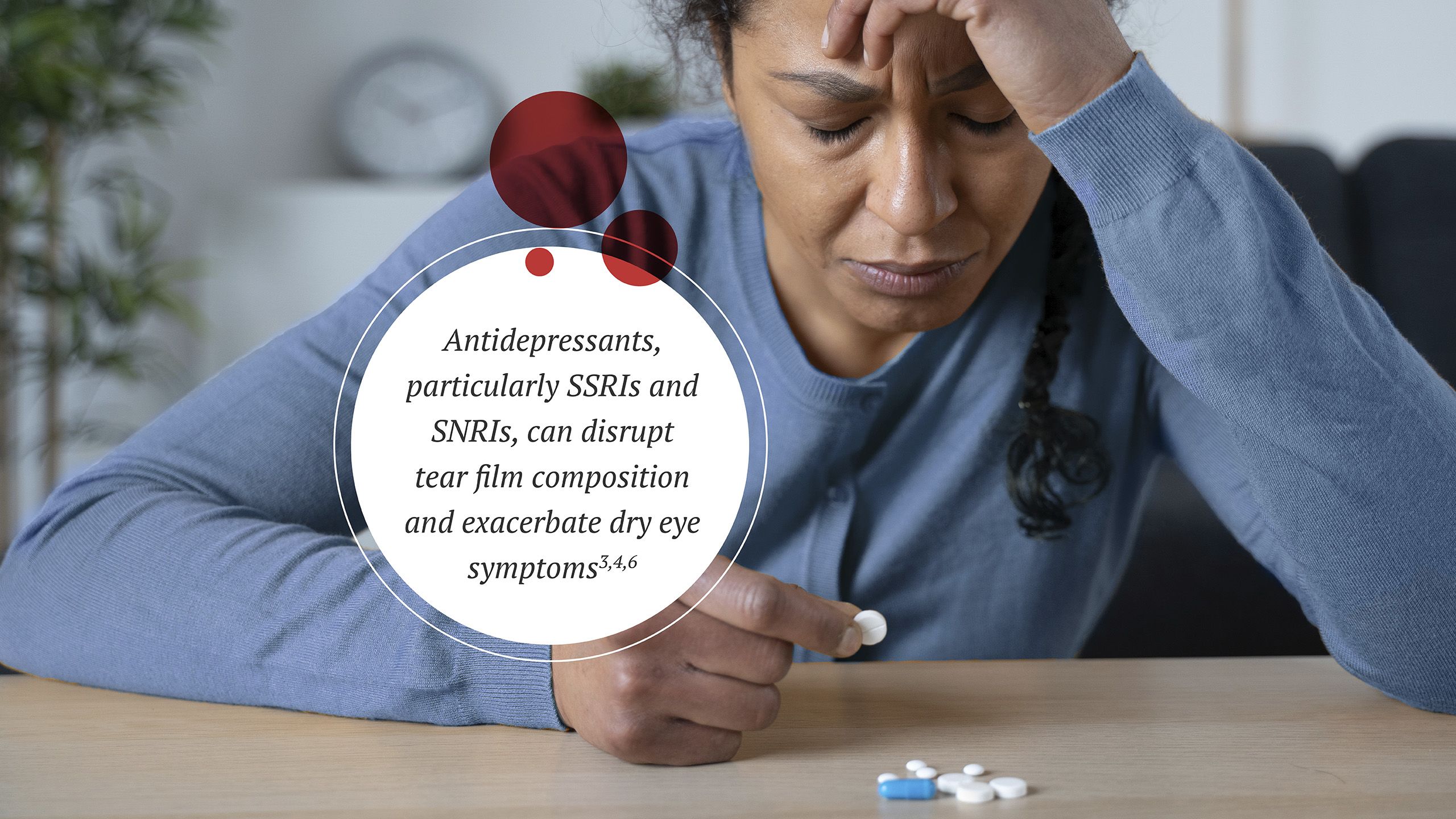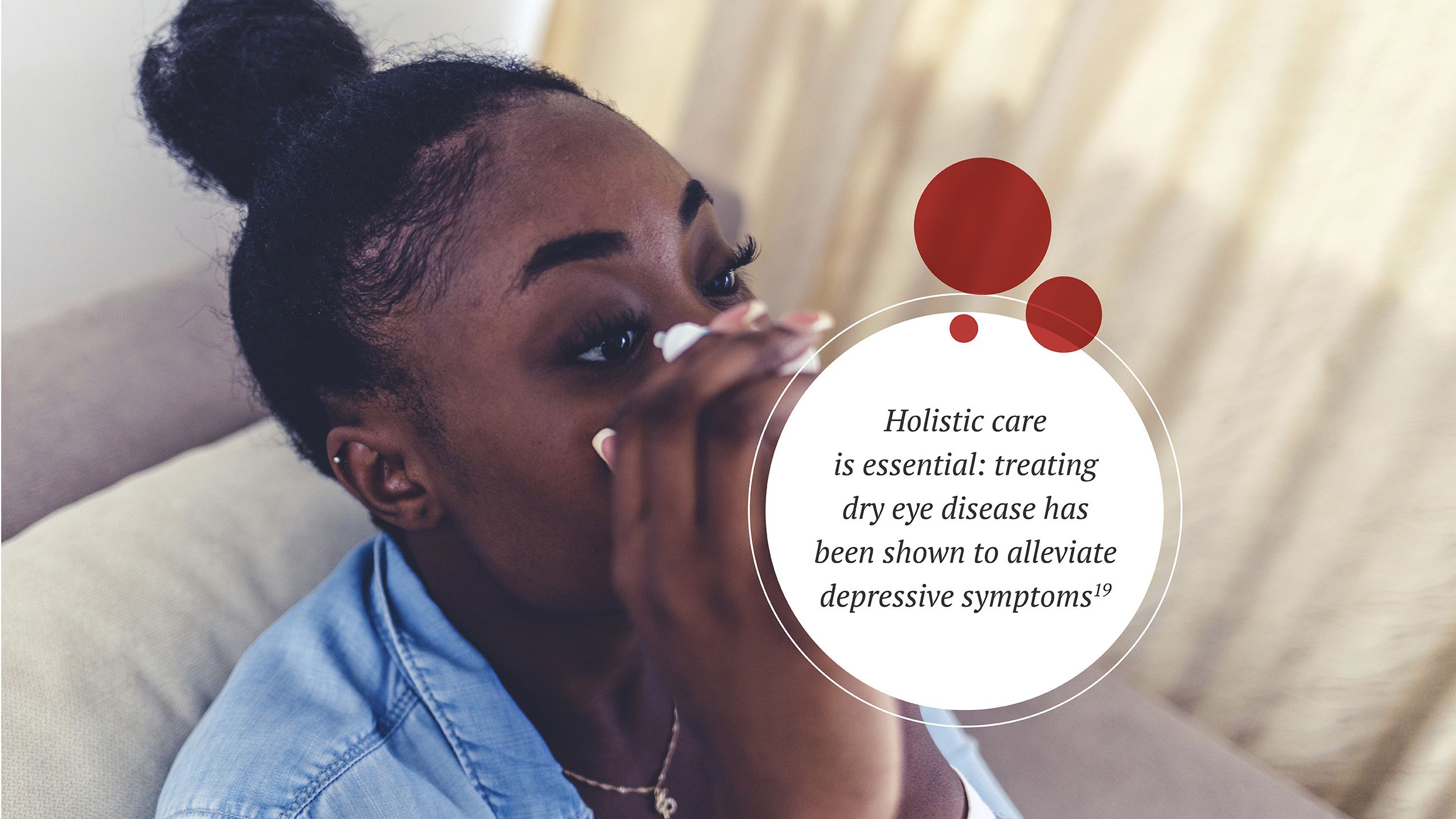
Understanding the interplay between mental health disorders (MHDs) and dry eye disease (DED) is essential for pharmacists who are at the forefront of improving patients’ quality of life (QoL). This article delves into the bidirectional relationship between these conditions, the impact on QoL, and the need for a comprehensive therapeutic approach.


PATIENTS WITH MENTAL HEALTH DISORDERS AND DRY EYE DISEASE
Mental health disorders such as depression, anxiety, bipolar disorder, and PTSD are alarmingly common in modern society.1,2,3 Several studies, as presented in available literature, show a significant prevalence of DED among individuals with MHDs.4,5,6 For instance, one case-control study revealed that people with depression exhibited a 24% prevalence of DED, compared to only 18% in those without mental health challenges.5
Key mechanisms explaining the association:
• Medication side effects: Many psychotropic drugs, including selective serotonin reuptake inhibitors (SSRIs) and serotonin-norepinephrine reuptake inhibitors (SNRIs), are known to disrupt tear film composition and impair lacrimal gland function.7,8
• Inflammation and Serotonin Dysregulation: Antidepressants often influence serotonin levels, which in turn affect ocular surface inflammation, contributing to DED symptoms.8
• Sleep deprivation: Sleep disturbances common in individuals with MHDs exacerbate tear instability and ocular surface discomfort, worsening DED.9-12
While poor mental health increases the risk of dry eye, dry eye can also lead to poor mental health.13





IMPACT ON QUALITY OF LIFE
Both DED and MHDs independently impose significant burdens on an individual’s QoL. Sleep quality and latency is a mediator of the relationship between mental health disorders, such as anxiety or depression, and DED.9
Sleep deprivation:
• Impairs lacrimal gland function, reduces tear secretion and tear hyperosmolarity11
• Increases inflammation and sensitivity to pain14
• Disrupts ocular surface health via mechanisms involving lipid metabolism dysregulation, leading to dry eye symptoms and impaired tear film stability12
Combined, their effects amplify physical discomfort, emotional distress, and social isolation.5,7,15-21 For example, patients diagnosed with severe DED consistently report higher depression and anxiety scores compared to those with mild variations of the disease. This underscores the necessity for integrating mental health considerations into ocular health management.22
ADDRESSING THE NEED FOR COMPREHENSIVE THERAPEUTICS
Given the complexity of DED subtypes, including aqueous deficient dry eye (ADDE), evaporative dry eye (EDE), and mixed dry eye (MDE), a one-size-fits-all approach is ineffective. Uniformly managing the diverse symptoms of these subtypes requires pharmacological interventions targeting the entire spectrum of DED.13,23-27 Pharmacists have a critical role in ensuring effective therapeutic outcomes by recommending multidimensional solutions.
Ideal treatment characteristics:
• Ideal eye drops should aim to address both inflammatory and volume-related insufficiencies to enhance management of DED, recognising the variability among subtypes.27
• Adjunctive management may benefit from systemic therapies aimed at supporting better sleep quality.9
Early and effective treatment of DED can positively impact the mental health of patients living with mental health disorders.28
ROLE OF THE PHARMACIST IN MULTIDISCIPLINARY CARE
Pharmacists should adopt a multidisciplinary approach, collaborating with eye care professionals, psychologists, and primary care physicians to:
• Identify red flags: Proactively recognise symptoms of undiagnosed DED among patients on psychotropic drugs.
• Promote early intervention: Encourage psychological screening alongside ocular evaluations to address both physical and emotional health.
• Educate patients: Raise awareness regarding medication-induced DED and encourage adherence to prescribed treatments.
Through these efforts, pharmacists can significantly contribute to clinical outcomes and overall patient well-being.
CONCLUSION
The association between mental health and DED underscores the importance of holistic, patient-centred care. Pharmacists play a pivotal role in bridging the gap between primary psychiatric care and specialised ocular management, ensuring improved QoL for patients facing both challenges. Collaboration across disciplines and judicious therapeutic selection are key to achieving optimal health outcomes.
REFERENCES
- GBD 2019 Mental Disorders Collaborators. Lancet Psychiatry. 2022;9(2):137-150.
- World Health Organization (WHO). COVID-19 pandemic triggers 25% increase in prevalence of anxiety and depression worldwide. Available at https://www.who.int/news/item/02-03-2022-covid-19-pandemic-triggers-25-increase-in-prevalence-of-anxiety-and-depression-worldwide. Accessed April 24 2023.
- World Health Organization (WHO). Mental disorders. Available at: https://www.who.int/news-room/fact-sheets/detail/mental-disorders. Accessed June 30 2023.
- Stapleton F, Alves M, Bunya VY, et al. TFOS DEWS II Epidemiology Report. Ocul Surf. 2017;15(3):334-365.
- Galor A, et al. Am J Ophthalmol. 2012;154(2):340-346.
- Liang CY, Cheang WM, Wang CY, et al. BMC Ophthalmol. 2020;20(1):123.
- Koçer E, Koçer A, Özsütçü M, et al. J Clin Psychopharmacol. 2015;35(4):411-413.
- Zhang X, Yin Y, Yue L, et al. Invest Ophthalmol Vis Sci. 2019;60(1):407-419.
- He Q, Chen Z, Xie C, et al. Front Psychiatry. 2022;12:802302.
- Li S, Ning K, Zhou J, et al. Exp Mol Med. 2018;50(3):e451.
- Lee YB, Koh JW, Hyon JY, et al. Invest Ophthalmol Vis Sci. 2014;55(6):3525-3531.
- Tang L, Wang X, Wu J, et al. Invest Ophthalmol Vis Sci. 2018;59(13):5494-5508.
- McMonnies CW. J Optom. 2021;14(1):3-10.
- Kourbanova K, Alexandre C, Latremoliere A. Front Neurosci. 2022;16:1009902.
- Wan KH, Chen LJ, Young AL. Eye Lond. 2016;30(12):1558-1567.
- Ayaki M, Tsubota K, Kawashima M, et al. Ophthalmol Vis Sci. 2018;59(14):DES143-DES150.
- Galor A. JAMA Ophthalmol. 2022;140(4):399-400.
- Miljanović B, Dana R, Sullivan DA, et al. Am J Ophthalmol. 2007;143(3):409-415.
- Morthen MK Magno MS, Utheim TP, et al. Ocul Surf. 2021;21:107-117.
- Inomata T, Iwagami M, Nakamura M, et al. JAMA Ophthalmol. 2020;138(1):58-68.
- Yu H, Weizhen Z, Minhui X, Wenyu W, Yun F. Frontiers in Medicine. 2022;9. 830986.
- Zhou Y, Murrough J, Yu Y, et al. JAMA Ophthalmol. 2022;140(4):392-399.
- Craig JP, Nichols KK, Akpek EK, et al. Ocul Surf. 2017;15(3):276-283.
- International Dry Eye Workshop. Ocul Surf. 2007;5:65-204.
- Kaštelan S, Bakija I, Bogadi M, et al. Psychiatr Danub. 2021;33(Suppl 4):580-587
- Van Der Vaart R, Weaver MA, Lefebvre C, et al. Am J Ophthalmol.2015;159:470-474.
- Messmer EM. Dtsch Arztebl Int. 2015;112(5):71-81.
- Bitar MS, Olson DJ, Li M, et al. Cornea. 2019;38(6):684-689.
@Alcon 2025 ZA-VC-2500006 Alcon Laboratories (South Africa) Pty (Ltd) Hertford Office Park, 90 Bekker Road, Vorna Valley, 1686 Tel: 011 840 2300. Co Reg No. 1977/000460/07
Image Credit: Getty Images



